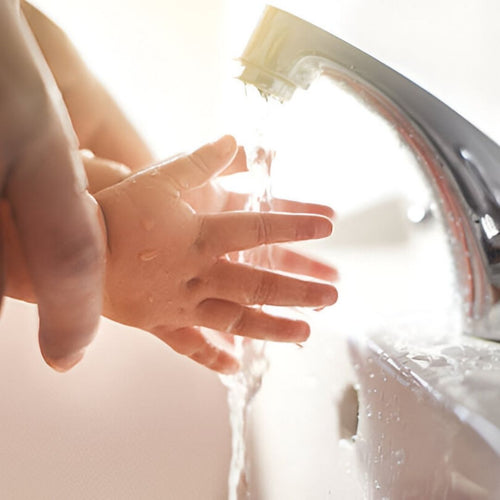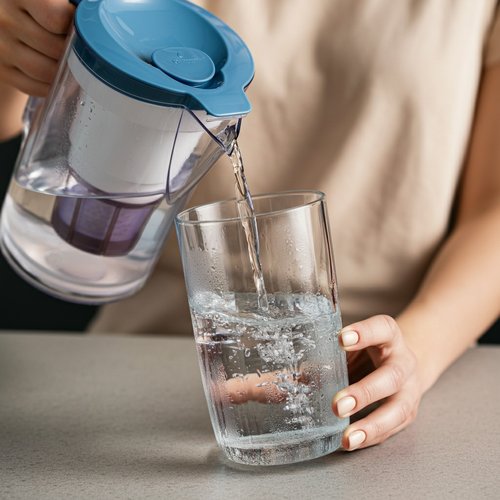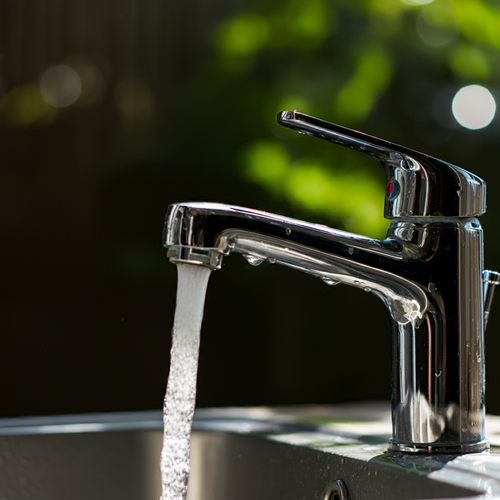Understanding Iron in Well Water
Lean in folks, well water users know the struggle. That pesky iron monster lurking can mess with both your water's taste and its safety profile.
Impacts on Water Quality
Way too much iron and we ain't just talking extra flavor in your water. Yup, we're diving into metallic tastes and that off-putting color you've probably noticed in your water or even dinner.
White shirts getting rusty, faucets looking like they've been through a war zone? Blame Mr. Iron. Tea and coffee taking on a new hue? Iron's putting on his special show with tannins – creating that weird sludge that turns your cup of joe into a chemistry set.

Iron-tinged water can also leave some serious stains, making your sinks and toilets look like abstract art galleries painted in reds and browns. We’re talking concentrations as low as 0.3 mg/L doing this dreadful work. Looks all clear in the glass but hit the air? It’s rust city!
Types of Iron Contamination
Turns out, iron’s got a few personalities:
-
Soluble (Dissolved) Iron: The common culprit. Those sneaky clear guys—before they get chatty with the air and show their true colors, leaving stains all over our beloved linens and, yep, our tongues feel the metallic zing.
-
Insoluble Iron: Unlike its clear buddy, it's got visible swagger—particles in your water waving hello. They dance around your pipes, trying to turn your plumbing into an iron-themed wonderland.
-
Iron and Manganese Bacteria: The party-poopers of the water world, these guys munch on dissolved iron and manganese, spewing out a slimy biofilm that sticks to pipes like gum to a shoe.
A one-size-fits-all approach ain't gonna cut it here. Each kind needs its own special treatment, and if we keep tabs on our well’s vibe with regular testing, we'll catch what's what, and which fix is the hero in this saga.
By knowing these iron villains and how they mess with our water vibe, we’ll be the rockstars of clean water—picking out filters that know how to deal with iron before it trashes our party.
Testing and Monitoring Iron Levels
Keeping an eye on the iron lurking in your well water is a big deal. We're talking about sidestepping that nasty metallic taste, annoying stains that make your fixtures look a hundred years old, and grumpy appliances that can't keep up.
Importance of Regular Testing
You don't wanna skip those well check-ups, trust us on this. Iron above 0.3 ppm is where the trouble begins, giving your water that unpleasant metal tang, and causing unwanted red or orange stains all over your sinks, tubs, and toilets.
Here’s a handy guide to see what too much iron does:
| Iron Level (ppm) | What Happens |
|---|---|
| 0.3 | Ugly stains on your plumbing and dishes |
| 0.5 | That weird metallic flavor |
| 1.0 | Slowpoke appliances, water barely drips out |
| 2.0+ | Everything gets worse—coffee turns black, mega stains, and more |
Give your well a test drive every year to catch these annoyances early and fix them quick.
Key Contaminants to Evaluate

Apart from iron, let’s chat about some of the other nasties that might be sneaking into your well water. Testing digs up the dirt on these baddies:
- Iron and Manganese: Both stain and mess with the taste. Manganese loves turning things black, like it's in mourning.
- Sediment: Straight up dirt and rocks making your water murky and clogging stuff up.
- Nitrate and Nitrite: Scary stuff at high levels, especially risky for your little ones.
- Arsenic: Nature dumped this nastiness, but long exposure isn't good for anyone.
- Hydrogen Sulfide: Making your water smell like rotten eggs and munching on your pipes.
Check out this list of usual suspects in well water:
| Contaminant | Where It Comes From | What's the Deal |
|---|---|---|
| Iron | Soil, rock erosion | Stains, metallic taste |
| Manganese | Soil, rock erosion | Stains, turns stuff black |
| Sediment | Soil, rock particles | Makes water dirty, blocks things |
| Nitrate/Nitrite | Fertilizers, septic systems | Health danger |
| Arsenic | Naturally sneaky | Toxic over time |
| Hydrogen Sulfide | Natural deposits, industry mess | Smelly, eats pipes |
Getting a handle on what’s in your water is step one to picking the perfect filter fit for your family’s needs..
Understand your well's quirks, and you’ll be ahead in the game of keeping your water fresh and safe for everyone at home.
Solutions for Treating Iron in Well Water
Alright folks, let's chat about the nitty-gritty of treating iron in your well water. If you're dealing with that stubborn iron, it's like your neighborhood trickster, sneaking into your morning coffee or that cool refreshing shower.
But don't worry, we're here to help you outsmart it. Let's break down the filtration options and pick the best one for your water woes.
Filtration Technologies
When it comes to well water with iron, not every filter is fit for the job. You need something cut out for this picky, iron-rich job.
Depending on what kind of iron is camping out in your water—whether it’s the see-through type, the flaky kind, or even a bacteria buddy—there's a match for you. Here's a round-up of what you can use:
- Oxidation Filtration Systems:
- These are like bouncers for your water, using oxidizing magic to get that soluble iron to be filter-friendly.
- They’re pretty versatile, even taking on iron bacteria—like high school bullies to these nuisances.
| Technology | Great For | You Should Know |
|---|---|---|
| Oxidation Filtration | Soluble, Insoluble, Iron Bacteria | Needs regular checkups |
- Whole-House Filtration Systems:
- For when you've got iron levels that should wear a warning label! These treat all your household water from top to bottom.
- They can also tackle a range of nasties like sediment, nitrate, and the pesky smell of rotten eggs.
| Technology | All-Inclusive | Quick Take |
|---|---|---|
| Whole-House Filtration | Entire home | Ideal if iron has moved in permanently |
- Water Softeners:
- While they're the masters of hard water, they're also smooth operators with iron levels of 2 to 5 milligrams per liter—think of it as a babysitter for mild iron troubles.
- Not your go-to for all iron types, though.
| Technology | Iron Levels Handled | Quick Take |
|---|---|---|
| Water Softeners | 2-5 mg/L Ferrous Iron | Also beats hard water blues |
Choosing the Right System

With a bunch of choices at your fingertips, picking the right filter feels a bit like dating—you want the perfect match. Here’s what to consider:
-
Know Your Iron:
- Figure out if your annoying guest is soluble, insoluble, or carrying bacteria.
- Water testing kits or calling in the pros can help pin it down.
-
Check the Iron Load:
- Take stock of how much iron you’re actually dealing with to pick the right fix.
| Iron Level | Best Fix |
|---|---|
| Low (< 2 mg/L) | Water Softener |
| Moderate (2-5 mg/L) | Water Softener or Whole-House Filter |
| High (> 5 mg/L) | Oxidation Filtration |
-
Look for Other Villains:
- Got more than just iron in your water? If sediment or hydrogen sulfide is part of the party, you may need a super-sleuth filter.
-
Factor in the TLC Needed:
- Some filters are high-maintenance, requiring a little more love and attention. Keep upkeep in mind when deciding.
Once you’re armed with this know-how, you can banish iron from your water, reclaiming fresh, clean water for a healthier home vibe. Cheers to turning tap disasters into happy hydro!
Features to Look For
Picking the right iron filter for well water is like setting up the perfect blind date with your well water. Here's what to keep an eye out for:
-
Filtration Style: These systems are doing some chemistry magic here. Oxidation turns iron you can’t see into iron you can, and then it’s curtains for the iron particles in your water.
-
Iron-Zapping Power: You’ll wanna know how much iron your filter can handle. Higher capacity is your buddy, especially if your well water's got more iron than an old car's carburetor.
-
System Size and Setup: Big problems? They'll need a system that's got your whole house covered, stopping those pesky rust marks and keeping your plumbing game strong.
-
Extra Features: Go for ones that tackle both iron and buddies like sulfur and manganese that like to crash the well water party more often than not.
-
Upkeep: Nobody’s got time for a needy filter. Choose something that’s not gonna demand your attention every five minutes. Self-cleaning sounds like heaven, doesn’t it?
-
Price Tag and Warranty: Think long-term here. A good filter should be worth every penny in future savings. Check out warranties and what kind of customer backup you've got for staying power.
Knowing these tricks, you'll land the perfect filter match that’ll keep your H2O clear and clean. Here’s to fresh, scale-free hydrating!


















![Aldex Premium 10% Cross Link Resin for Water Softener [High Capacity]-SoftPro® Water Systems](http://www.softprowatersystems.com/cdn/shop/files/Aldex_10_Cross_Link_Resin_Premium_High_Capacity_for_Water_Softener_600x.jpg?v=1735853599)






















